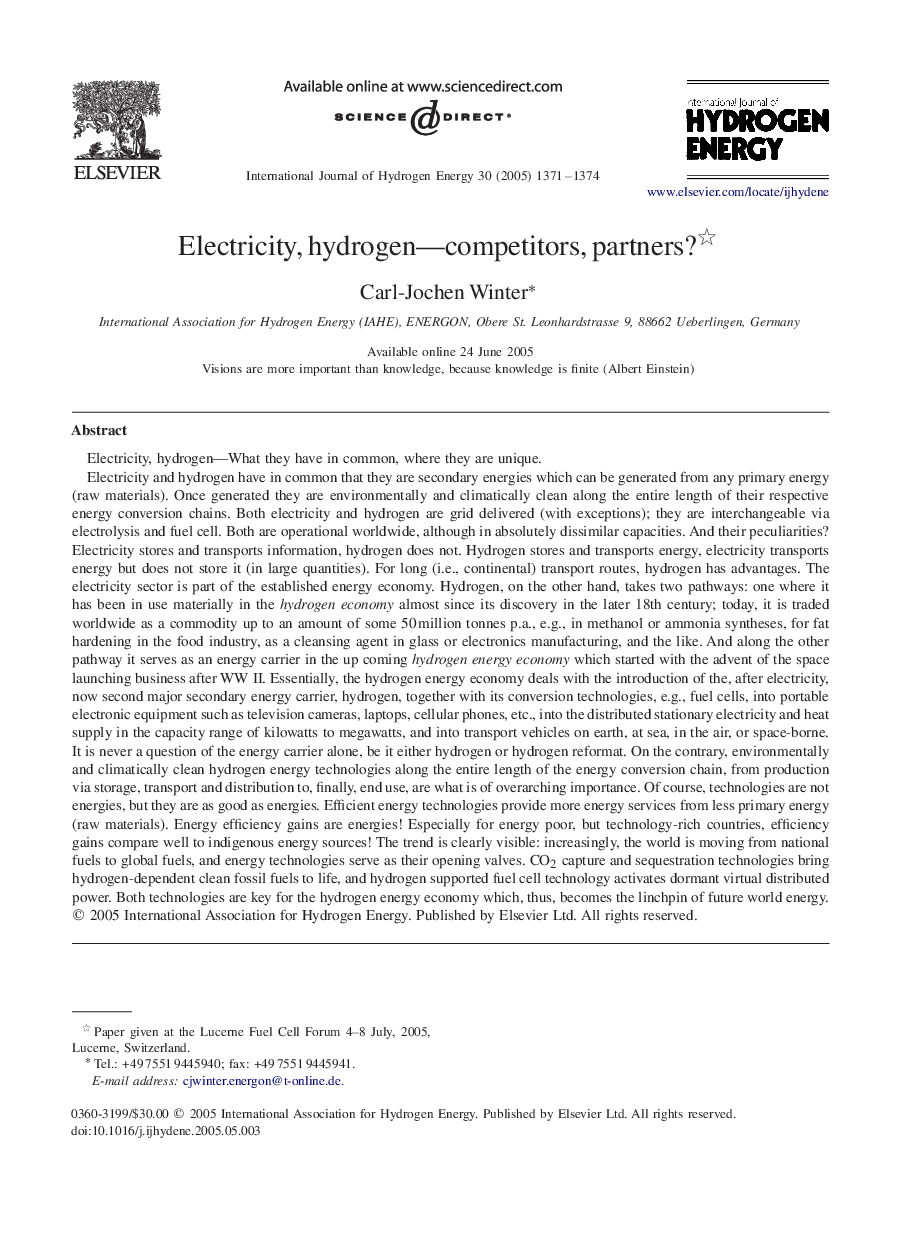| کد مقاله | کد نشریه | سال انتشار | مقاله انگلیسی | نسخه تمام متن |
|---|---|---|---|---|
| 9759203 | 1497699 | 2005 | 4 صفحه PDF | دانلود رایگان |
عنوان انگلیسی مقاله ISI
Electricity, hydrogen-competitors, partners?
دانلود مقاله + سفارش ترجمه
دانلود مقاله ISI انگلیسی
رایگان برای ایرانیان
موضوعات مرتبط
مهندسی و علوم پایه
شیمی
الکتروشیمی
پیش نمایش صفحه اول مقاله

چکیده انگلیسی
Electricity and hydrogen have in common that they are secondary energies which can be generated from any primary energy (raw materials). Once generated they are environmentally and climatically clean along the entire length of their respective energy conversion chains. Both electricity and hydrogen are grid delivered (with exceptions); they are interchangeable via electrolysis and fuel cell. Both are operational worldwide, although in absolutely dissimilar capacities. And their peculiarities? Electricity stores and transports information, hydrogen does not. Hydrogen stores and transports energy, electricity transports energy but does not store it (in large quantities). For long (i.e., continental) transport routes, hydrogen has advantages. The electricity sector is part of the established energy economy. Hydrogen, on the other hand, takes two pathways: one where it has been in use materially in the hydrogen economy almost since its discovery in the later 18th century; today, it is traded worldwide as a commodity up to an amount of some 50Â million tonnes p.a., e.g., in methanol or ammonia syntheses, for fat hardening in the food industry, as a cleansing agent in glass or electronics manufacturing, and the like. And along the other pathway it serves as an energy carrier in the up coming hydrogen energy economy which started with the advent of the space launching business after WW II. Essentially, the hydrogen energy economy deals with the introduction of the, after electricity, now second major secondary energy carrier, hydrogen, together with its conversion technologies, e.g., fuel cells, into portable electronic equipment such as television cameras, laptops, cellular phones, etc., into the distributed stationary electricity and heat supply in the capacity range of kilowatts to megawatts, and into transport vehicles on earth, at sea, in the air, or space-borne. It is never a question of the energy carrier alone, be it either hydrogen or hydrogen reformat. On the contrary, environmentally and climatically clean hydrogen energy technologies along the entire length of the energy conversion chain, from production via storage, transport and distribution to, finally, end use, are what is of overarching importance. Of course, technologies are not energies, but they are as good as energies. Efficient energy technologies provide more energy services from less primary energy (raw materials). Energy efficiency gains are energies! Especially for energy poor, but technology-rich countries, efficiency gains compare well to indigenous energy sources! The trend is clearly visible: increasingly, the world is moving from national fuels to global fuels, and energy technologies serve as their opening valves. CO2 capture and sequestration technologies bring hydrogen-dependent clean fossil fuels to life, and hydrogen supported fuel cell technology activates dormant virtual distributed power. Both technologies are key for the hydrogen energy economy which, thus, becomes the linchpin of future world energy.
ناشر
Database: Elsevier - ScienceDirect (ساینس دایرکت)
Journal: International Journal of Hydrogen Energy - Volume 30, Issues 13â14, OctoberâNovember 2005, Pages 1371-1374
Journal: International Journal of Hydrogen Energy - Volume 30, Issues 13â14, OctoberâNovember 2005, Pages 1371-1374
نویسندگان
Carl-Jochen Winter,